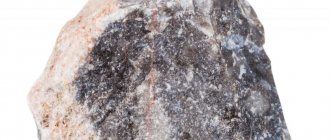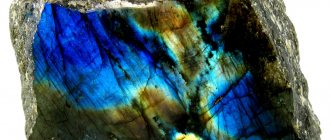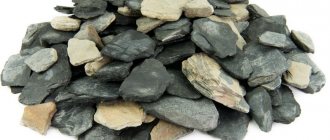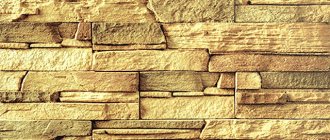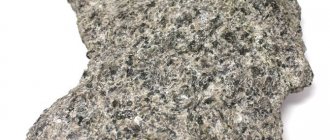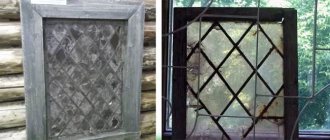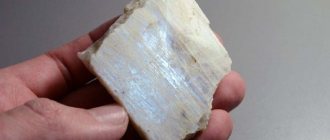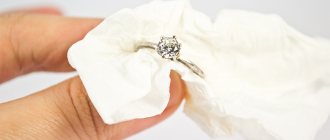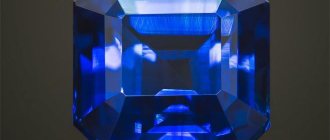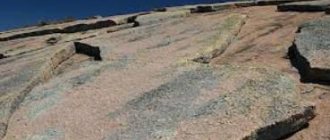And the city, and the stone, and the shoes... And it seems that these words have nothing in common, but this is a deceptive statement. “I’m in Slantsy, I’m going for shale in Slantsy!” - exclaimed a resident of the city of the same name, walking to a hardware store in flip-flops. Well, if they know about the famous city in which shoes were made for the Soviet Union, not many have heard about the slate rocks.
Natural slate
History of the stone
The word slate is formed not from the verb to send, as can rightly be noted, but from lay, lay. In the old days, this is what they called schist... Schists are a metamorphic (altered) rock formed during the Ordovician period 500 million years ago, formed from dark-colored minerals, feldspar or quartz. The concept of metamorphism is the change under pressure and temperature of an existing rock in the depths of the earth's crust in an environment of gases and aqueous solutions due to volcanic and tectonic processes. Increasing temperature accelerates chemical reactions, promotes recrystallization, increases porosity and thus permeability to various minerals and fluids. The result is a rock that shimmers in the sun.
General concept
The name slate hides a whole range of rocks with very diverse properties and appearance. What these rocks have in common is the presence of layered (parallel) intergrowths of medium- or low-temperature minerals. Eg:
- actinolite;
- quartz;
-muscovite;
- chlorite;
- epidote, etc.
Often, shale rocks can preserve all sorts of relict structures in good condition, which are sort of preserved between layers. This is primarily characteristic of the Solenhofen shales, which were presumably formed in ancient sea lagoons. All shales belong to the so-called metamorphic rocks.
Their characteristic feature is the ability to split into tiles or thin plates. This ability is called foliation. Shales are divided according to several parameters, one of them is the method of formation. They are divided into:
- Orthoshales - formed during the metamorphism of igneous rocks;
- Paraschists are formed as a result of the transformation of sedimentary rocks.
They are also divided according to the degree of metamorphism:
- weakly metamorphosed;
- intermediate metamorphosed;
- deeply metamorphosed.
Interestingly, the formation of these minerals depends on several factors in addition to chemical composition. The main one is the depth at which the formation process took place. In other words, an important factor is thermodynamic conditions. So if such conditions are strong, these rocks become crystalline schists.
Next we will look at several types of slates in more detail.
What does it look like
Natural slate is a rock with a schistose structure. According to the established rule, the name is given according to the rock-forming minerals according to the 1-2-3 scheme. The mineral that is the least abundant in a mineral and becomes the first in the name:
- chlorite – chlorite, epidote, quartz;
- garnet - garnet, quartz, feldspar.
In general, the color of the stone is varied, with pronounced shades, mainly depending on the host minerals. The most common are gray and black. The black color has a graphite tint with a matte sheen, while the gray one has an oily sheen predominates.
Black slate
Slate multicolor
Gray slate
Slate black graphite
Natural burgundy slate
Slate is...
Slate is a rock in which the minerals are arranged in layers, almost parallel to each other. It has a heterogeneous chemical composition, which may include minerals such as quartz, albite, chlorite, serpentine, feldspars, micas, graphites, etc.
The appearance of shale largely determines the amount and type of minerals the rock contains, as well as the presence of various impurities. Shades of the stone range from yellow and brown to purple, red or gray.
The rock is based on minerals of dark shades, so the most common in nature is black slate, and also gray. Light-colored stones are less common. As a rule, they have an attractive shine and are valued in crafts. The breed is black and gray in color and does not shine, but has a matte surface.
Slate is a stone that is over 400 million years old. Preserved remains of fossil organisms are often found in the rock. Shales belong to metamorphic rocks, that is, they were formed as a result of changes in chemical and physical conditions - metamorphosis.
Physico-chemical characteristics and varieties
More than 3 thousand mineral agglomerates are known in the world. For description and classification, a diagnostic technique based on physical, mechanical and chemical properties is used. This is necessary for an unambiguous identification of a particular mineral resource. Physical characteristics mean:
- optical:
- color;
— transparency;
- shine;
- mechanical:
— hardness;
- cleavage;
- special (the ability to deflect a magnetic needle, a characteristic garlic smell after rubbing, plasticity and others).
To further understand the concept of rock hardness, it is useful to become familiar with the Mohs scale, named after the 18th-19th century German mineralogist and geologist.
| Name of mineral | Appearance | Hardness | Machinability |
| Talc | 1 | Nail scratches remain | |
| Gypsum | 2 | Nail scratches remain | |
| Calcite | 3 | Traces of a copper coin remain | |
| Fluorite | 4 | Scratched by a steel nail or glass shard | |
| Apatite | 5 | Scratched by a steel nail or a piece of glass, but only with force | |
| Orthoclase | 6 | Mineral scratches glass, can be processed with a file | |
| Quartz | 7 | Processed with diamond, leaves scratches on glass | |
| Topaz | 8 | Processed with diamond, leaves scratches on glass | |
| Corundum | 9 | Processed with diamond, leaves scratches on glass | |
| Diamond | 10 | Cuts glass |
Let's consider the properties of slates, which have become widespread in industrial sectors, construction and decorative crafts.
- Clayey is a hard rock with a cryptocrystalline structure from gray to reddish in color with a matte sheen. It has a variety of shades and color saturation. Consists mainly of clay minerals, hardness 2-4 (slips on glass without leaving scratches). In rare cases, the presence of quartz may leave scratches. The presence of carbonate inclusions (calcite, marl, dolomite) is indicated by a chemical reaction with hydrochloric acid. The strength characteristics are significantly influenced by schistosity and cracks. The strength is low, it breaks easily along the schistose plane, varies from 20 MPa for talc and chlorite schists to 100-200 MPa for mica schists, however, for clayey schists the figure is less than 20 MPa. Almost all samples are anhydrous. According to the composition of minerals, they are divided into: – calcareous – contains calcite (5-22%), enters into a chemical reaction when exposed to hydrochloric acid; – siliceous-clayey – contains silica, is quite strong and hard; – roofing – capable of stratification into small-thick solid plates; – graphite – grayish, due to graphite crystals it leaves a line on the surface of the paper, dirtying your hands, tactilely greasy and soft; – bituminous – due to the presence of bitumen in the composition – black. When heated, a specific smell appears; – carbonaceous – black in color, draws on paper, but weakly. Hardness is low.
- Mica slate. It mainly contains various micas, hence the name. The color varies and is due to the micas contained in the rock. Includes sericite (thin scales), biotite, muscovite (light color). Forms a silky pearlescent sheen, sometimes silvery with a coarse-scale structure. The main difference from other types is the greater presence of mica relative to quartz. According to the composition of minerals it is divided into: – biotite (black shale); – muscovite (light); – double mica (same muscovite-biotite ratio); – mica-chlorite (difference from other varieties – the presence of chlorite, has a greenish color). – sericite is represented by sericite flakes, light gray in color with greenish inclusions. Clay mineralization is minimal. Hardness 3 (scratches plaster).
- The slate is nodular. Sometimes called mottled due to its texture and presence of mineral inclusions (spots). Color with a wide range, from dark gray to brown. Cryptocrystalline structure with mineral inclusions in the node zone. Pronounced mottled texture. Clay minerals interspersed in hematite and magnetite nodes are rock-forming. Stone samples react to a magnetic needle.
- Talc slate. It got its name because of its slate-like structure and the predominant presence of talc. A white, sometimes yellowish rock with a fine-grained structure, consisting of talc (greasy, leaves fingernail marks), quartz (scratches glass), and inclusions of calcite and chlorite (greenish color). Distinctive feature – soft, hardness on the scale – 2.
- Chlorite shale. It owes its name due to its schistosity and chlorite content. There is a beautiful green slate shimmering in the sun. With a cryptocrystalline structure, crystals of ore inclusions are often visible. Contains talc and chlorite and has a slightly greasy feel. Hardness value - 2.5. If there is more talc, then the shale is chlorite-talc, if there is mica, then it is chlorite-mica.
There are also oil shale, but we’ll talk about them a little later.
Properties and composition of mica slate
Physical properties. The structure is schistose, granular-schistose. Mica schist is composed of mica or mica and quartz. The color of the breed is white, brown, black. Mica schist is characterized by a schistose, banded structure and mica content. Compressive strength is about 70 MPa. Density 2.86 g/cm3.
Mineral composition . The rock is composed mainly of flakes of mica (most often either biotite or muscovite), quartz and chlorite. Quartz inclusions are often located in the rock in the form of ellipses. Graphite is often included in mica slate, giving a lead-gray color. The rock may also contain additional minerals, such as garnet.
Chemical composition . SiO2 30-45%, Al2O3 10-40%, MgO up to 25%, FeO 3-20%, Fe2O3 up to 20%, K2O 5-12%, etc.
Places and methods of extraction
The main large deposits of shale minerals are located in Russia (Caucasus, Urals, Altai Territory), USA, Germany, France and Spain. Claystones are mined in quarries or mines in blocks. Then they are split into slabs of the required sizes for ease of transportation. Typically, blocks are formed according to dimensions (1-5 meters) and stacked in parallel layers. Large panels are rare. This is due to the intensity of the occurrence; waste sometimes accounts for up to 80% of the extracted raw materials. After the shale rock is separated, sorting occurs. The highest grade is formed from products with a thickness tolerance of no more than 1 mm. Thus, the pack contains a batch with a nominal value of 5 mm with a discrepancy in standard size of 4-6 mm. Quality requirements depend on mining conditions and vary from country to country. For America, resistance to weathering is important, but for the European continent, conditions for frost resistance are required. Each country is guided by its own criteria and standards. The most demanding quality standard in the world is French; in addition, all manufacturers undergo EU certification. Today, the problem of depletion of European quarries arises, so many suppliers purchase minerals from the Asian region. Such rock material is considered “young”. Through selection, this product is passed off as European. Cheap products are often offered instead of high-quality ones. Shale materials do not support the load, crack, have irregular geometry, and are sometimes radioactive. Laboratory testing is recommended before purchase. The main supplier in Europe today is Spain. The share of development and production of this state in the Old World is 90%. In Latin America, Brazil ranks first in the development of roofing slate. It is also in second place in the world in production after Spain. There are more than 100 quarries in Brazil, as well as 500 processing plants. There are also deposits in Russia, located in the Urals and North Ossetia. Unfortunately, our country is completely dependent on imports, and production and development is of a focal nature, often in small teams for specific needs. There is hope that the deposits of the Caucasus will be appreciated and will find their buyer.
Magic properties
Since ancient times, people have endowed minerals with the power of magic. There is a belief that our wonderful stone also provides a subtle connection between man and the cosmos. Of course, this is not so easy to do the first time and right away, so there is a certain ritual. At midnight, when the Moon is full, light 2 candles, place a shale shard between them and gaze at it for half an hour. He himself will show all his strength. After some time, pictures and images of figures will appear. Ask him to interpret these visions, and he will do it. Only for this you need to put it under the pillow, after wrapping it in a silk scarf. The interpretation of what you see will happen in a dream.
Artificial slate
Decorative slate is the best solution for those who want to express their special uniqueness of original design in the interior decoration of their home. Artificial stone has excellent technical characteristics, is easy to process and is no different in appearance from natural stone. The manufacturing process occurs by mixing basalt chips with modern plasticizers, or from gypsum. Gypsum tiles with imitation brick or stone are used in dry rooms, as they strongly absorb water.
Decorative slate in the interior
The artificial product has a number of advantages:
- lighter weight compared to natural slate;
- use in any climatic conditions;
- ease of installation;
- less waste and formation of a cut without chipping;
- elasticity and durability.
Crystal shales
This type of slate has a number of distinctive features, the first and most obvious of which is, of course, its structure, which is clear from the name itself. The second, determined visually by the presence of a pronounced banded texture.
In terms of composition, traditionally this type of shale contains a predominant amount of quartz, biotite and muscovite. The last two are familiar to most of us under the term mica. Some of them also include amphiboles, scapolite, pyroxenes or plagioclase. There are also cases when the composition of such shale also includes dark-colored minerals.
In addition, it should be noted that this type of shales often contains specific rocks of metamorphic minerals, such as:
- almandine, familiar to us under the name garnet;
- andalusite;
- staurolite and kyanite;
- sillimanite and scapolite.
In rare cases, carbonates and other substances are found. If we consider the mineral composition, crystalline schists are divided into:
- andalusite-biotite schists;
- diopside-scapolite, plagioclase or carbonate shales;
- quartz-bearing mica schists;
- garnet-biotite schists, etc.
Price
Slate roofing tiles are expensive compared to traditional materials. The high cost is due to the difficulty of extracting and manually processing each element. Prices for slate roofing from Spain start from 3,500 rubles per 1 m2. Brazilian products are in the same price range. The German manufacturer offers a price range from 2850 to 9750 rubles per square meter. Prices for dishes made from this stone depend on the complexity of processing, the image of the author and the use of accompanying materials (valuable wood, glass). For example, a simple cutting board will cost 1 thousand rubles, a stone for finishing knives will cost 650 rubles.
Respect for one’s personality and a reverent attitude towards health should be demonstrated by every person. Products made from slate will complement life with stone tranquility, and the call of our ancestors will remind us of our roots.
